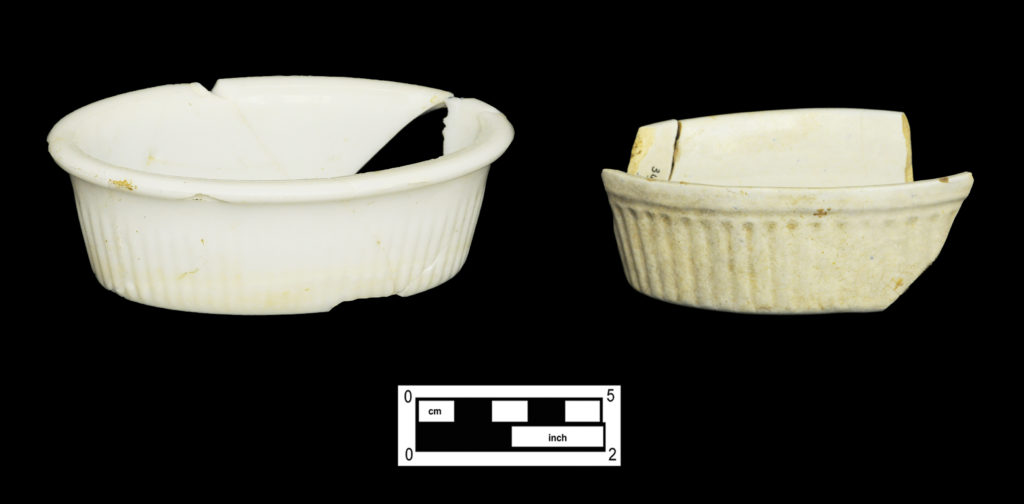Artifacts representing the presence of pets in a nineteenth-century household are often difficult to distinguish from other domestic objects. Period newspapers document the popularity of cage birds in Philadelphia—particularly song birds, such as canaries and mockingbirds.
Bird Cage Baths

Two small dishes—one made of glass and the other ceramic—are similar in size and oval shaped (4A-G-0293 and 4A-C-0086). The outside of each dish features a band of narrow, vertical flutes. The glass dish was pressed from opaque white glass, while the other was molded from refined earthenware clay, either whiteware or white granite. Initially, these vessels were thought to be small serving dishes; however, further research reveals that they are baths for cage birds.
These bath dishes provided convenient containers for small amounts of water to be placed in the bottoms of cages, allowing birds to clean themselves. The dishes were usually removed between baths to prevent birds from getting a chill and making a mess.
Price lists from the Pittsburgh glass firm M’Kee and Brothers dating from around 1859 through 1871 list bird baths and illustrate a shallow oval dish with a pattern of rounded flutes on the exterior. 1 The Whitall, Tatum & Company of Millville, New Jersey, advertised a wide range of glassware in their shops in Philadelphia and New York. Their catalog for 1880 offered flint (colorless) and opaque glass bird baths in large and small sizes, in addition to a “mocking bird bath.” 2
Gillinder and Sons Glass Wares Manufacturers, located at the corner of Oxford and Howard Streets in Philadelphia, also advertised bird baths. A Gillinder catalog dating from about 1881–1889 illustrates two bird baths labeled “No. 1” and “No. 2,” with no observable distinguishing characteristics noted between the two. 3 Each appears on a black background similar to an opal egg and castor set on the same page, which seems to suggest that the two baths were also made of opaque white glass. Bird baths of similar shape in two sizes of opal glass were offered in the Butler Brothers of Chicago wholesale catalog of 1906. 4
The white ceramic dish of similar size, shape, and decoration most likely also represents a bird bath. Oval whiteware bird baths Nos. 1, 2, and 3 were listed for sale by the Swan Hill Pottery in South Amboy, New Jersey, as recorded in a price list dating from about 1852–1855. 5
The presence of two different bird baths suggests that birds may have been pets at different times or of more than one of the families occupying the house.
References
- M’Kee and Brothers, M’Kee Victorian Glass Five Complete Glass Catalogs from 1859/60 to 1871 (New York, NY: Dover Publications, 1981), 13, 16, 55, 178 ↩
- Whitall, Tatum & Company, Whitall, Tatum & Co., 1880: Flint Glassware, Blue Ware, Perfume and Cologne Bottles, Show Bottles and Globes, Green Glassware, Stoppers, Druggists’ Sundries 1880 (Princeton, NJ: American Historical Catalog Collection, Pyne Press, reprint 1971), 18 ↩
- Gillinder and Sons Glass Ware Manufacturers catalog, p. 23, from collection of Corning Museum of Glass, available at Opensalts.US, accessed April 2014, http://opensalts.us/References/Catalogs/US/USA-Gillinder1881-89-eW.jpg ↩
- Craig S. Schenning, A Butler Brothers Catalog Collection Vol. 1: 1896–1906 (Hampstead, MD: Old Line Publishing Reference Book, 2009) 123 ↩
- Joan Leibowitz, Yellow ware The Transitional Ceramic (Exton, PA: Schiffer Publishing, 1985), 33 ↩







